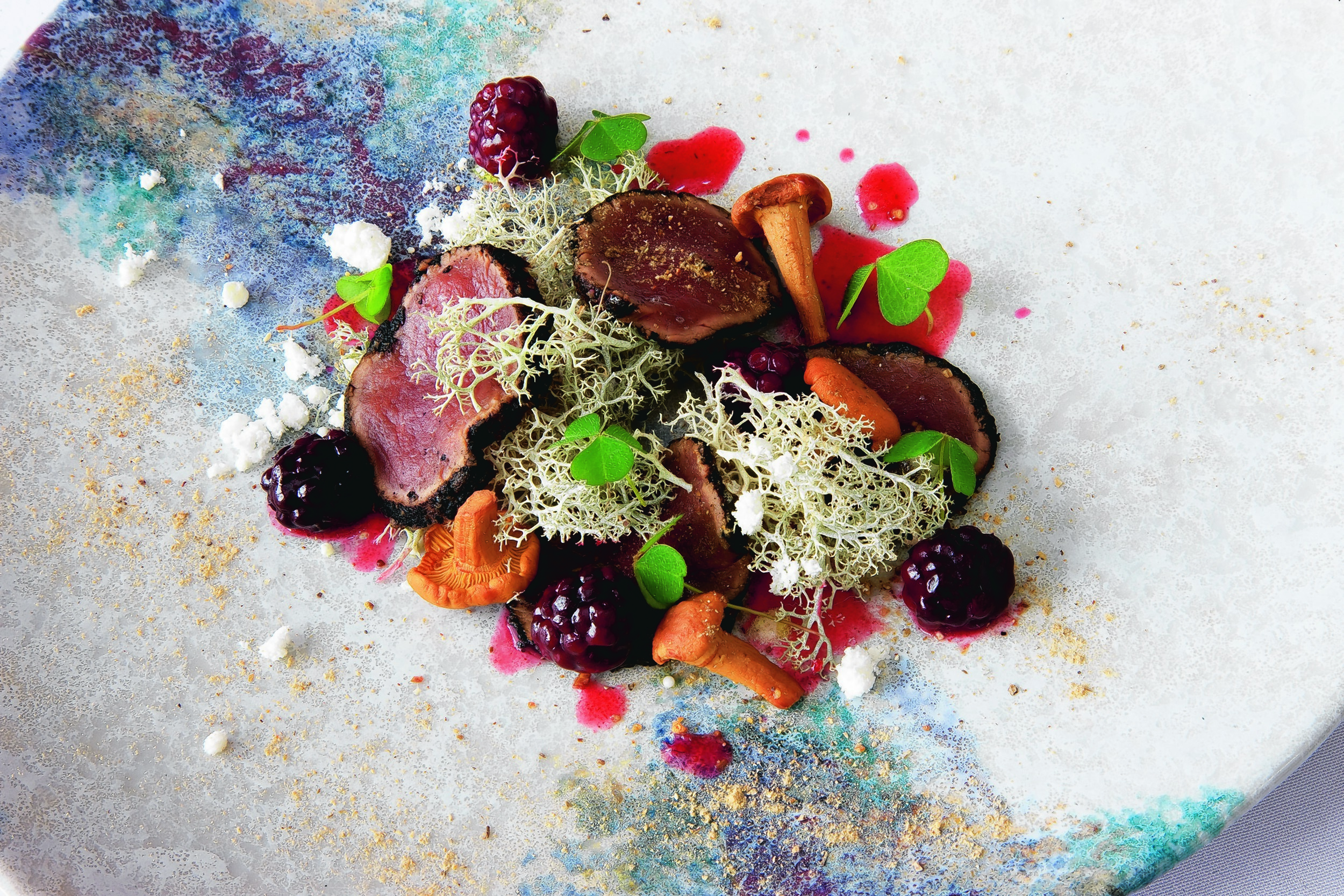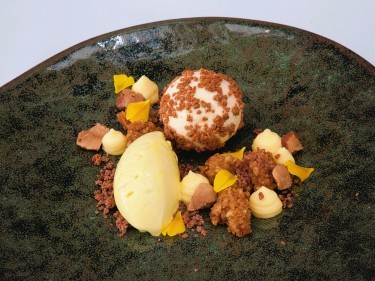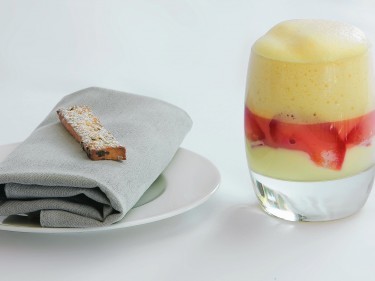Having helped the Isle of Eriska Hotel, Spa & Island win its first Michelin star this autumn, head chef Ross Stovold shows YL magazine how to create show-stopping dishes at home
Ross joined the team at the five-star hotel last summer and has a very natural approach to his cuisine. He believes in cooking in a way that develops and enhances the flavours of the ingredients through as little manipulation as possible, but as you’ll see from these recipes, he’s also keen on using some unusual ingredients.
VENISON CARPACCIO WITH FOREST GATHERINGS
SERVES 4
This dish was the result of an early morning mushroom-picking session; it was before sun rise and we were walking through the forest in near complete darkness en-route to our secret spot for chanterelles.
As visibility was so low, the smells of the forest around us was heightened, especially the pine trees.
As the sun rose through the trees and we reached our destination, all that was around us became the inspiration for the dish; mushrooms, moss, brambles, wood sorrel; we climbed the last hill and off to our left a roe deer fawn bounced out of the bracken and down the hill. The final element of our forest gathering plate.
Never gather wild ingredients you aren’t 100% sure of – the wrong identification can be deadly. Always seek the advice of an expert before you delve into this hidden world around us.
1 saddle of venison
10 onions
500g Scots Pine needles
1 litre rapeseed oil
Maltodextrina tapioca powder
200g brambles
50g water
50g caster sugar
50g white wine vinegar
Reindeer moss or 1 small cabbage
100g chanterelles
For the carpaccio, remove the loins from a saddle and trim any excess sinew from the meat.
In an extremely hot pan, evenly seal the loin. Don’t season the meat yet as this will just scorch in the heat. While cooking, roll the loin in onion ash. This is simply barbecued onions until they reach a blackened state, dried out and blended to a powder. Finally, wrap tightly in cling film and leave in the fridge for at least 4 hours.
Meanwhile, collect branches from a medium-sized Scots Pine tree taking care not to damage the tree and allowing the clipping to grow back. Remove the needles and infuse 500g in one litre of rapeseed oil at 20C for two days. When infused, strain the oil and mix a small amount of the oil with tapioca maltodextrina to create a pine powder.
Make a bramble dressing by selecting the least ripe berries, but not the ones that are still red.
Cover in salt for two hours and rinse. Boil equal amounts of water, sugar and white wine vinegar; allow to cool slightly and pour over the brambles and steep. This can be kept for months in a clean, sterilised jar.
Reindeer moss isn’t available to all so could be exchanged for cabbage or kale. We collect the moss, being extremely careful we have the right species. Once collected, it’s soaked in water and sterilising tablets for 15 minutes and then well rinsed, spun in a salad spinner and dried.
Once dried, we deep fry it at 160C and dust it with cep powder as soon as it leaves the oil. Cep powder is all the large ceps we have picked, dried and blended into a powder to use all year round.
For the chanterelles, simply cook them very gently in an emulsion of water and butter making sure they retain some texture.
To assemble the dish, thinly slice the carpaccio and season with juniper salt, (dried juniper blended with sea salt). Arrange the moss on a plate and drape the venison around this. Place the rest of the elements around the moss, including the mushroom emulsion so that the diner gets all the elements on their fork when they eat it. Finish with scattered wood sorrel.
GORSE FLOWER ICE CREAM, BURNED WHITE CHOCOLATE AND ALMOND MILK
SERVES 8
I came up with the idea for this recipe while walking back from the beach after picking seaweed from the waters surrounding the island.
Gorse is littered all over the island and as I was walking, a gust of wind blew around me and filled my nose with a strange coconut-like smell.
I realised the gust had passed through a gorse bush. I tasted one of the flowers, knowing it was edible as I had recently read a recipe for gorse wine. The coconut flavour was really strong, so I gathered as much as I could fit into my pockets.
FOR THE ICE CREAM
380g gorse flowers, washed in vegetable disinfectant
12 egg yolks
200g sugar
1,200g full fat milk
200g milk powder
FOR THE WHITE CHOCOLATE PARFAIT
400g white chocolate
1kg semi-whipped cream
12 egg yolks
200g water
240g caster sugar
FOR THE ALMOND MILK
400g whole almonds
600g water
To make the ice cream, infuse the flowers in the boiled milk for one hour, then blend and pass through a fine chinois.
Warm the milk back up, and whisk together the yolks and sugar. Pour the milk on to yolk mix and cook in a clean pan until the anglais reaches 85C. Pour through a chinois on to milk powder and whisk. Freeze and churn.
To make the parfait, melt the white chocolate over a bain marie, boil the sugar and water to 116C.
Meanwhile, whip the yolks until doubled in volume, carefully drop sugar and water into yolks and continue to whip until the mixing bowl is cool on the bottom.
Fold the melted chocolate into the yolks and then fold the cream into the mix, being careful not to over mix. Set into moulds and freeze.
For the burned chocolate, place the white chocolate on to a baking tray with non-stick mat, bake for nine minutes on 170C. Allow to cool and break up.
To make the almond milk, roast the almonds on 160C for 10 minutes. Blend with the water, and pass through a chinois.
To serve, roll the parfait in the burned white chocolate, scoop the ice cream on to a plate and arrange all elements around it, breaking extra chocolate on at the end.
DUCK EGG CUSTARD, SPICED PLUM, WHISKY SABAYON AND GARIBALDI BISCUIT
SERVES 4
7 large duck eggs
1 pint of double cream
250g golden caster sugar
12 plums
1 cinnamon stick
1 star anise
Black pepper
5g red wine vinegar
50g butter
40g icing sugar
50g plain flour
40g egg whites
50g currants
3 chicken eggs
80g water
35g white caster sugar
Salt
400ml whisky of your choice
For the custard, separate six of the duck eggs and mix with the whole egg and 150g of the caster sugar until all are combined.
You don’t need to whip this mixture. Meanwhile, gently bring the cream to the boil. Slowly pour the boiled cream over the egg and sugar mix while continuously whisking.
Pour into a clean pan and cook on a medium heat until the mixture reaches 82C. Immediately pour through a fine sieve taking care not to force through any lumps.
Allow to cool at room temperature for 30 minutes first before setting the custard in your glasses in the fridge. This stops a sudden change in temperature creating condensation inside the glasses and on the surface of the custard.
For the spiced plum compote, cut the plums in half and remove the stone. Now cut into quarters and remove the skin, chop each quarter into four. Place the plums, 100g golden caster sugar, cinnamon, star anise, red wine vinegar and three good turns of black pepper from a mill in a pan and cook until all the liquid has evaporated leaving a thick compote.
For the Garibaldi, melt the 50g of butter and mix with the flour and icing sugar until smooth. Add the currants and fold in 40g egg whites, chill for one hour. Roll the mix out to 5mm thickness between two sheets of baking paper and chill for another 30 minutes. Prick with a fork and bake at 180C for 25 minutes. Cut the biscuit while it’s still warm.
For the sabayon, reduce the whisky to 150ml. (We use a 10-year-old Talisker for its peat and smokey flavours). Melt the white caster sugar and water together and chill. In a metal bowl, combine two egg yolks, one whole egg, the sugar and water mixture and a pinch of salt. Whisk this over a pan of simmering water being careful to make sure the water isn’t touching the bottom of the bowl as this will overcook the eggs.
You need to whisk this mixture until it forms soft peaks then add the reduced whisky. While whisking every couple of minutes, touch the bottom of the bowl to make sure it’s not getting too hot. If it’s too hot for your hand, then it’s getting too hot for the eggs, continue to whisk off the heat for a few moments and then return to the simmering water.
To assemble, remove the custard from the fridge half an hour before serving, add the warm compote and finish with the sabayon. The Garibaldi is best served warm.


